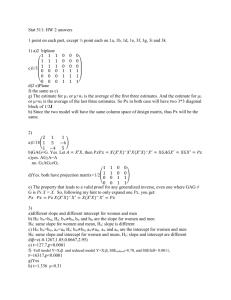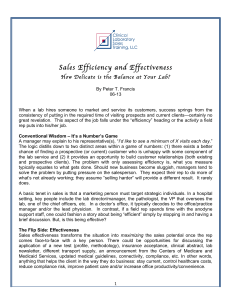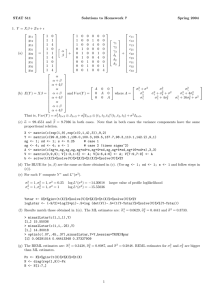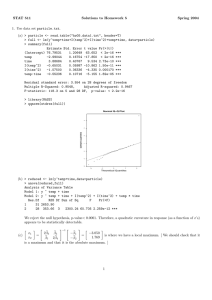STAT 511 Solutions to Homework 1 Spring 2004
advertisement
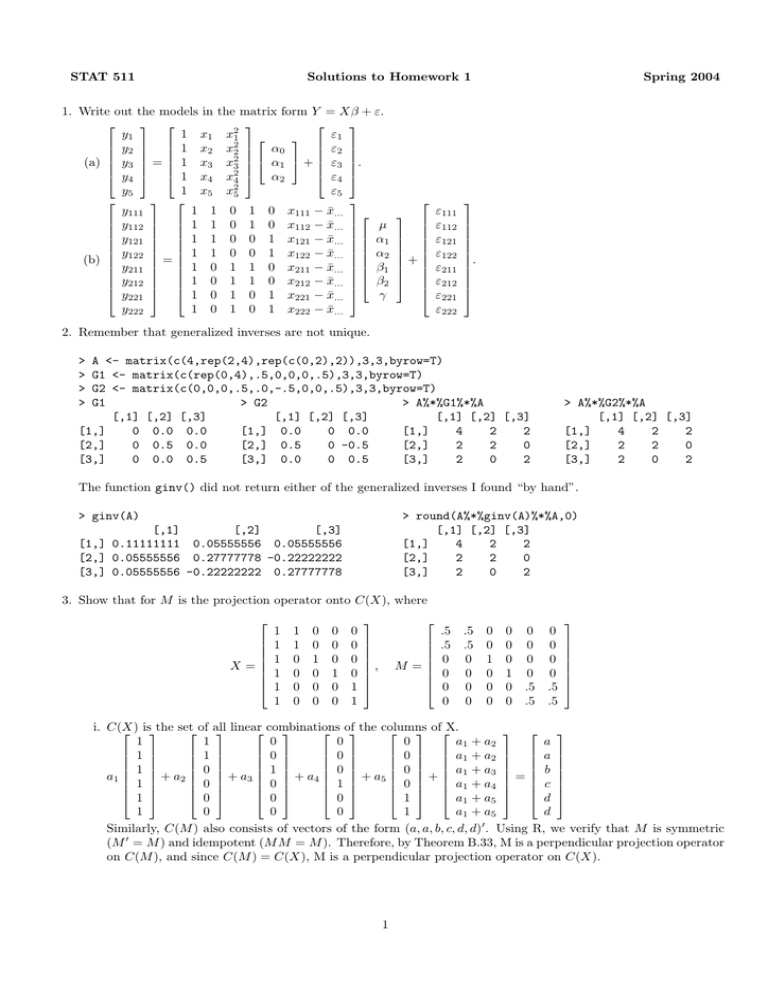
STAT 511 Solutions to Homework 1 1. Write out the models in the matrix form Y = Xβ + ε. y1 1 x1 x21 ε1 y2 1 x2 x22 α0 ε2 2 ε3 (a) y3 = 1 x3 x3 α1 + . y4 1 x4 x24 α2 ε4 y5 1 x5 x25 ε5 y111 1 1 0 1 0 x111 − x̄... y112 1 1 0 1 0 x112 − x̄... µ y121 1 1 0 0 1 x121 − x̄... α1 y122 1 1 0 0 1 x122 − x̄... α2 = (b) y211 1 0 1 1 0 x211 − x̄... β1 y212 1 0 1 1 0 x212 − x̄... β2 y221 1 0 1 0 1 x221 − x̄... γ y222 1 0 1 0 1 x222 − x̄... 2. Remember that generalized inverses are not unique. + ε111 ε112 ε121 ε122 ε211 ε212 ε221 ε222 Spring 2004 . > > > > A <- matrix(c(4,rep(2,4),rep(c(0,2),2)),3,3,byrow=T) G1 <- matrix(c(rep(0,4),.5,0,0,0,.5),3,3,byrow=T) G2 <- matrix(c(0,0,0,.5,.0,-.5,0,0,.5),3,3,byrow=T) G1 > G2 > A%*%G1%*%A [,1] [,2] [,3] [,1] [,2] [,3] [,1] [,2] [,3] [1,] 0 0.0 0.0 [1,] 0.0 0 0.0 [1,] 4 2 2 [2,] 0 0.5 0.0 [2,] 0.5 0 -0.5 [2,] 2 2 0 [3,] 0 0.0 0.5 [3,] 0.0 0 0.5 [3,] 2 0 2 > A%*%G2%*%A [,1] [,2] [,3] [1,] 4 2 2 [2,] 2 2 0 [3,] 2 0 2 The function ginv() did not return either of the generalized inverses I found “by hand”. > ginv(A) > round(A%*%ginv(A)%*%A,0) [,1] [,2] [,3] [1,] 4 2 2 [2,] 2 2 0 [3,] 2 0 2 [,1] [,2] [,3] [1,] 0.11111111 0.05555556 0.05555556 [2,] 0.05555556 0.27777778 -0.22222222 [3,] 0.05555556 -0.22222222 0.27777778 3. Show that for M is the projection operator onto C(X), where X = 1 1 1 1 1 1 1 1 0 0 0 0 0 0 1 0 0 0 0 0 0 1 0 0 0 0 0 0 1 1 M = , .5 .5 0 0 0 0 .5 .5 0 0 0 0 0 0 1 0 0 0 0 0 0 1 0 0 0 0 0 0 .5 .5 0 0 0 0 .5 .5 i. C(X) isthe set of all linear combinations of the columns ofX. 1 1 0 0 0 a1 + a 2 a 1 1 0 0 0 a1 + a 2 a 1 0 1 0 0 a1 + a 3 b a1 + a 2 0 + a 3 0 + a 4 1 + a 5 0 + a1 + a 4 = c 1 1 0 0 0 1 a1 + a 5 d 1 0 0 0 1 a1 + a 5 d 0 Similarly, C(M ) also consists of vectors of the form (a, a, b, c, d, d) . Using R, we verify that M is symmetric (M 0 = M ) and idempotent (M M = M ). Therefore, by Theorem B.33, M is a perpendicular projection operator on C(M ), and since C(M ) = C(X), M is a perpendicular projection operator on C(X). 1 > X <- matrix(c(rep(1,8),rep(c(rep(0,6),1),3),1),6,5) > M <- matrix(c(rep(c(.5,.5,0,0,0,0),2),0,0,1,rep(0,6),1,rep(0,6),.5,.5,rep(0,4),.5,.5),6,6,byrow= > t(M) > M%*%M [,1] [,2] [,3] [,4] [,5] [,6] [,1] [,2] [,3] [,4] [,5] [,6] [1,] 0.5 0.5 0 0 0.0 0.0 [1,] 0.5 0.5 0 0 0.0 0.0 [2,] 0.5 0.5 0 0 0.0 0.0 [2,] 0.5 0.5 0 0 0.0 0.0 [3,] 0.0 0.0 1 0 0.0 0.0 [3,] 0.0 0.0 1 0 0.0 0.0 [4,] 0.0 0.0 0 1 0.0 0.0 [4,] 0.0 0.0 0 1 0.0 0.0 [5,] 0.0 0.0 0 0 0.5 0.5 [5,] 0.0 0.0 0 0 0.5 0.5 [6,] 0.0 0.0 0 0 0.5 0.5 [6,] 0.0 0.0 0 0 0.5 0.5 ?i. [Another choice to show C(X) = C(M )]. Let X = (X 1 , . . . , X 5 ) and M = (M 1 , . . . , M 6 ). Note that every column in X can be written as a linear combination of columns in M . Therefore, C(X) = C(M ). P X1 = 5i=1 Mi , X2 = M1 + M2 , X3 = M3 , X4 = M4 , X5 = M5 + M6 and M1 = 21 X2 , M2 = 12 X2 , M3 = X3 , M4 = X4 , M5 = 21 X5 , M6 = 12 X5 . ii. We compute PX = X(X 0 X)− X 0 which is the projection operator onto C(X) and, it matches the matrix proposed in the statement of this question. > Px <- X%*%ginv(t(X)%*%X)%*%t(X) > round(Px,1) [,1] [,2] [,3] [,4] [,5] [,6] [1,] 0.5 0.5 0 0 0.0 0.0 [2,] 0.5 0.5 0 0 0.0 0.0 [3,] 0.0 0.0 1 0 0.0 0.0 [4,] 0.0 0.0 0 1 0.0 0.0 [5,] 0.0 0.0 0 0 0.5 0.5 [6,] 0.0 0.0 0 0 0.5 0.5 4. For the same X as in question 3, suppose that Y = (2, 1, 4, 6, 3, 5)0. (a) Let G1 and G2 0 0.0 0 0.5 G1 = 0 0.0 0 0.0 0 0.0 be two 0 0 0 0 1 0 0 1 0 0 different generalized inverses for (X 0 X), and let bi 0.0 0.12 −0.02 0.08 0.08 −0.02 0.0 0.42 −0.18 −0.18 0.0 0.72 −0.28 , G2 = 0.08 −0.18 0.08 −0.18 −0.28 0.0 0.72 0.5 −0.02 −0.08 −0.18 −0.18 = Gi X 0 Y for i = 1, 2. −0.02 −0.08 −0.18 . −0.18 0.42 Note that Ŷ = Xbi = (1.5, 1.5, 4, 6, 4, 4)0 for i = 1, 2; but b1 = (0, .5, 4, 6, 4)0 and b2 = (3.1, −1.6, 0.9, 2.9, 0.9)0. (b) > > > > X <- matrix(c(rep(1,8),rep(c(rep(0,6),1),3),1),6,5) Y <- c(2,1,4,6,3,5) Px <- X%*%ginv(t(X)%*%X)%*%t(X) Yhat <- Px%*%Y i. ii. iii. iv. v. vi. Ŷ = (1.5, 1.5, 4, 6, 4, 4)0. Y − Ŷ = (0.5, −0.5, 0, 0, −1, 1)0. Ŷ 0 (Y − Ŷ ) = 0. Y 0 Y = 91. Ŷ 0 Ŷ = 88.5. (Y − Ŷ )0 (Y − Ŷ ) = 2.5. 3 0 −1 0 . 5. Let Y = (y1 , y2 , y3 )0 with Y N (µ, V ) where µ = (0, 1, 0)0 and V = 0 5 −1 0 10 (a) y3 ∼ N (0, 10). y1 0 3 −1 (b) ∼N , . y3 0 −1 10 (c) y3 |y1 = 2 ∼ N (−2/3, 29/3). 2 (d) y3 |y1 = 2, y2 = −1 ∼ N (e) y1 y3 = −1 y2 0+ −1 0 3 0 0 5 −1 2−0 −1 − 1 , 10 − −1 0 3 0 0 5 −1 −1 0 = N (−2/3, 29/3) f (y3 |y1 , y2 ) = f (y3 |y1 ). 0 0 3 −1 0 ∼ N + [1/5][−1 − 1], − [1/5] 0 0 −1 10 0 0 0 . 0 3 −1 = N , f (y1 , y3 |y2 ) = f (y1 , y3 ) 0 −1 10 ! (f) Find the correlations ρ12 , ρ13 , ρ23 p i. ρ12 = 0/ 3(5) = 0. p √ ii. ρ13 = −1/ 3(10) = −1/ 30. p iii. ρ23 = 0/ 5(10) = 0. 1 3 1 −1 1 0 1 −1 1 −1 16 1 (g) Z ∼ N E(Y ) + , Cov(Y ) −1 1 =N , . 3 1 0 1 3 1 0 2 1 32 1 0 6. Using the function eigen() to obtain eigenvalues and eigenvectors of a matrix V we are able to compute its inverse square root, W = V −1/2 = U D−1/2 U 0 . Note that W W = V −1 . > > > > V <- matrix(c(3,-1,1,-1,5,-1,1,-1,3),3,3,byrow=T) EV <- eigen(V) W <- EV$vectors%*%diag(1/sqrt(EV$values))%*%t(EV$vectors) W [,1] [,2] [,3] [1,] 0.61404486 0.05636733 -0.09306192 [2,] 0.05636733 0.46461562 0.05636733 [3,] -0.09306192 0.05636733 0.61404486 > W%*%W [,1] [,2] [,3] [1,] 0.38888889 0.05555556 -0.11111111 [2,] 0.05555556 0.22222222 0.05555556 [3,] -0.11111111 0.05555556 0.38888889 > solve(V) [,1] [,2] [,3] [1,] 0.38888889 0.05555556 -0.11111111 [2,] 0.05555556 0.22222222 0.05555556 [3,] -0.11111111 0.05555556 0.38888889 7. > A <- matrix(c(4,4.001,4.001,4.002),2,2) > B <- matrix(c(4,4.001,4.001,4.002001),2,2) > det(A);det(B) # determinants of A and B, respectively. [1] -1e-06 # 4*4.002-4.001*4.001 [1] 3e-06 # 4*4.002001-4.001*4.001 > ginv(A) [,1] [,2] [1,] -4002000 4001000 [2,] 4001000 -4000000 > ginv(B) [,1] [,2] [1,] 1334000 -1333667 [2,] -1333667 1333333 > 3*ginv(B) [,1] [,2] [1,] 4002001 -4001000 [2,] -4001000 4000000 3

